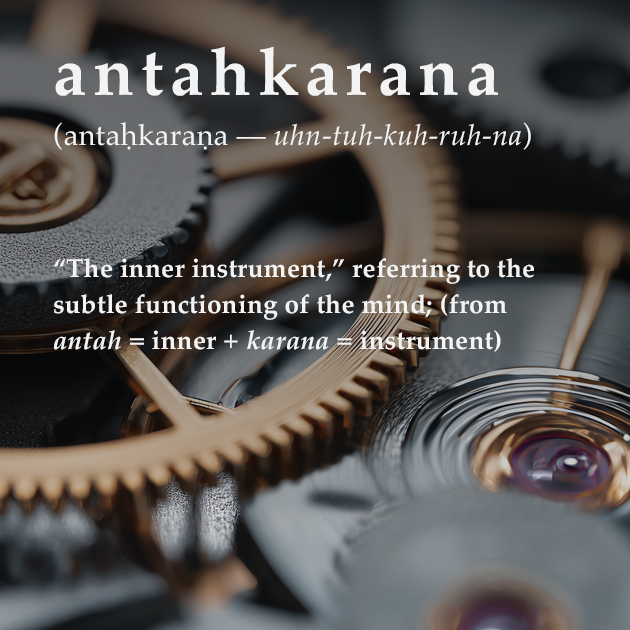Antahkarana - The Inner Instrument of Mind and Its Fourfold Functions
- Daniel McKenzie

- Sep 6
- 3 min read
Updated: Dec 11

The sages speak of the mind as if it were one thing, but Vedanta refines the picture. What we casually call “mind” is actually a set of coordinated faculties, together called the antahkarana (antaḥkaraṇa) — the “inner instrument.” Just as the body is an instrument for action in the world, the antahkarana is the instrument through which the Self experiences, interprets, remembers, and identifies.
The term is significant: “inner” because it belongs to the subtle body, unseen by others yet immediately available to one’s own awareness; “instrument” because it is not the Self itself but a tool of transaction. The antahkarana does not shine on its own. Like the moon borrowing light from the sun, it derives its illumination from consciousness. Without the Self as witness, the mind would be inert, a dark mirror.
The tradition distinguishes four functions within the antahkarana:
Manas (mind): the faculty of desire, doubt, and emotion. It vacillates, considers options, and feels.
Buddhi (intellect): the faculty of determination and discrimination. It decides, reasons, and concludes.
Chitta (memory): the storehouse of impressions and recollections. It retrieves the past to inform the present.
Ahankara (ego): the sense of individuality and doership, the “I” that claims experience.
Though divided in function, these are not separate organs. They are different facets of a single subtle instrument, like one crystal reflecting light in many colors.
Vedanta emphasizes that the antahkarana is anatma — not the Self. It is known, variable, and dependent, while the Self is the constant knower. Still, it plays a vital role: liberation requires a mind that is purified, steady, and prepared. Karma yoga, devotion, meditation, and ethical living all have as their immediate aim the refinement of the antahkarana. Only such a mind can reflect the knowledge of the Self clearly, like a polished mirror.
When the antahkarana is restless, the world seems overwhelming. When it is sattvic, quiet, and clear, it reveals the truth that the Self was ever free.
Root & Meaning
Antaḥ = inner
Karaṇa = instrument
Together, “the inner instrument,” referring to the subtle functioning of mind.
Scriptural References
Tattvabodha: identifies the fourfold division of antahkarana — manas, buddhi, chitta, and ahankara.
Bhagavad Gita (6.5): speaks of uplifting oneself by the Self, which requires mastery over the inner instrument.
Upanishads: frequently refer to the mind (manas) and intellect (buddhi) as the key mediators of experience and knowledge.
Traditional View
The antahkarana is a central component of the subtle body (sukshma sharira). It coordinates perception (via the sense organs), action (via karmendriyas), and experience. Its four functions are:
Manas (mind): doubt, desire, emotion.
Buddhi (intellect): discrimination, reasoning, decision.
Chitta (memory): storing and retrieving impressions.
Ahankara (ego): self-identity, ownership, doership.
Vedantic Analysis
The antahkarana is essential for experience, yet it is not the Self. It is subtle matter, a modification of prakriti, and therefore inert by nature. It becomes enlivened only in proximity to consciousness. Like a mirror reflecting light, it reveals but does not generate illumination.
For Vedanta, the goal is not to destroy the antahkarana but to refine it. A mind disciplined by karma yoga and meditation becomes sattvic and clear, capable of reflecting Self-knowledge without distortion. In realization, the antahkarana continues to function — the jnani still thinks, decides, remembers, and says “I” — but without misidentification. The instrument is known as an instrument, not mistaken for the Self.
Common Misunderstandings
Equating antahkarana with just “mind”: In Vedanta it is a fourfold faculty, not a single undifferentiated organ.
Assuming it is the Self: The antahkarana is known, variable, and limited — hence anatma.
Believing liberation requires killing the mind: The antahkarana is not to be destroyed but purified, stabilized, and understood in its proper role.
Vedantic Resolution
The antahkarana is indispensable for living and for liberation. With it, the Self can transact in the world and undertake inquiry. When purified, it reflects the Self’s light steadily, allowing knowledge to dawn. When mistaken as the Self, it binds. Freedom lies in discriminating between the ever-free witness and this subtle inner instrument.
